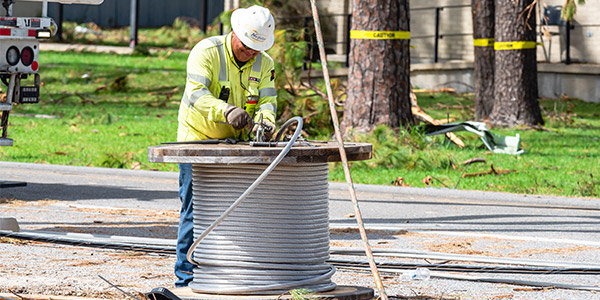MISO staff continue to keep advisories in effect and compile data on the MISO South emergency and subsequent rolling blackouts caused last week by Hurricane Laura.
The RTO said Laura was the strongest storm to hit Louisiana in 150 years.
“The southeastern Texas and southwestern Louisiana areas of the MISO footprint sustained substantial damage to the transmission facilities under MISO’s functional control, as well as to interconnected generation and distribution facilities, requiring careful and deliberate focus on maintaining system stability,” the RTO said.
Laura’s path of destruction Aug. 27 caused MISO to direct Entergy to employ periodic power outages in the western half of the West of the Atchafalaya Basin (WOTAB) load pocket that spans the Texas-Louisiana border. (See MISO Enacts Rolling Blackouts in Laura Aftermath.)
MISO said that as a result of the widespread grid damage, the area’s constraint locations have temporarily changed. It said it is investigating the locations to include them in modeling.
“It is important that any unique restoration system conditions are captured correctly in MISO’s market models and the bids and offers they clear, to properly incentivize additional, economic generation as part of the restoration efforts,” MISO said.
The grid operator reported that $3,500/MWh value of lost load pricing was in effect for some of the WOTAB’s commercial nodes from 11:40 a.m. to 10:55 p.m. ET on Aug. 27.
MISO has put standing capacity and transmission advisories in place for the areas affected by the hurricane, warning members that generation and transmission capacity could become scarce as restoration work continues. It also canceled a monthly training drill on firm load shedding planned for Sept. 2 in MISO South because of an extended conservative operations declaration through Monday in some areas.
Chris Miller, FERC liaison to MISO, thanked MISO South members for their restoration efforts along the Gulf of Mexico and surrounding areas.
“I know it’s a big event. It’s an ongoing situation, and I want to give a hearty ‘thank you’ to everyone working to get power back to people,” Miller said during a Reliability Subcommittee meeting Thursday.
Entergy said the bulk of lingering outages lies in its Louisiana territory. The utility said that as of Thursday, it has restored 81% of the 616,000 power outages caused by Laura; however, it also said that more than 108,000 of the 271,000 Louisiana customers affected by Laura remain without electricity. The company said nearly all the 291,300 Texas customers affected by the hurricane would be restored by Friday.
Entergy said it is committed to a swift restoration but warned that customers in the city of Lake Charles and Cameron and Calcasieu parishes will “face weeks” without power.
“Our damage assessments indicate catastrophic damage to our electrical infrastructure. We expect the recovery to be as difficult and challenging as we have ever faced in the past,” Entergy said. “The damage from Hurricane Laura’s historic intensity caused catastrophic damage to the Entergy system across Louisiana and Texas. The eye wall, which brings the most damaging winds and intense rainfall, passed directly over Lake Charles, La., causing wide-spread damage to that area and our system.”
Entergy reported 219 out-of-service transmission lines, 292 damaged substations and sizable distribution system damage.
SPP CEO Barbara Sugg said before, during and after the storm’s landfall, there was coordination among SPP, MISO, ERCOT, regulators, American Electric Power and the Edison Electric Institute.
“Together, we addressed voltage and severe loading issues, monitored required load sheds and mitigated the risk of major, potentially catastrophic outages both during the event and through restoration efforts,” Sugg said in an emailed update. “Certainly, load shed events are unfortunate and undesirable. However, I’m proud of the interregional coordination to protect the bulk electric system.”
She said she has received “messages of gratitude” from MISO leadership.
More Detail on July Emergency
Meanwhile, MISO staff last week released more information on the July 7 maximum generation event that affected its North and Central regions.
Speaking during the RSC meeting, MISO System Operations Senior Adviser Gerald Rusin said the RTO may not have needed to enact emergency measures. He said MISO’s North and Central regions were spared from more intense heat by widespread pop-up thunderstorms that began around 1 p.m. July 7. While generation and load-modifying resources’ emergency ratings were available to meet forecasted load, Rusin said LMR use wasn’t necessary. (See Max Gen Event Managed Efficiently, MISO Says.)
“At the time that we made the declaration, the numbers were pointing that way,” he said, citing forecasted temperatures in the low 90s in the North and Central regions and a “near peak” combined load of 88.5 GW for the two regions.
COVID-19 pandemic load profiles that continue to be unpredictable also contributed to some uncertainty during the event, Rusin said. He said unplanned generation outages have been steadily increasing since April, possibly because of the pandemic. By July, unplanned outages had risen to more than 10 GW, uncharacteristically high for the month known for peak demand, he said.
“We need to see how this plays out in the months to come to see if the true effects of COVID caused the pattern to persist in this way,” Rusin said.
Ultimately, systemwide MISO load peaked at 114 GW for the month on July 8. The RTO experienced an average 88.4-GW load during the month, slightly higher than 2019’s 88.1-GW systemwide average.
Executive Director of Real-Time Operations Rob Benbow said MISO will update its termination declarations after some stakeholders said it wasn’t completely clear through RTO communications which emergency steps ended and when during the July event.
“We want to make sure it’s clear and that everyone is on the same page as we step down protocols,” Benbow said.





